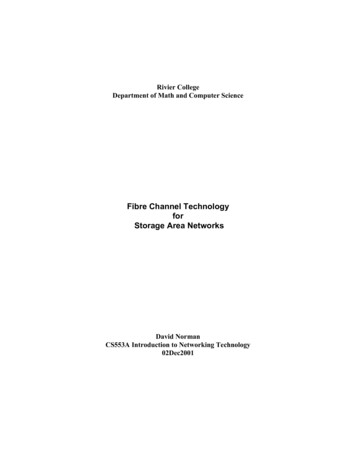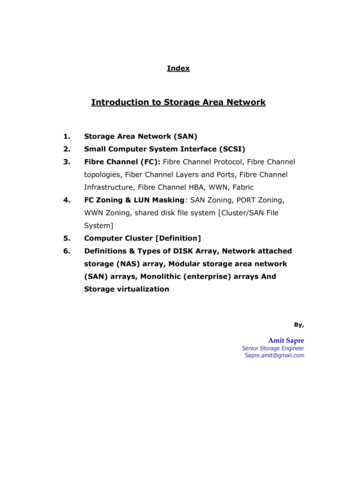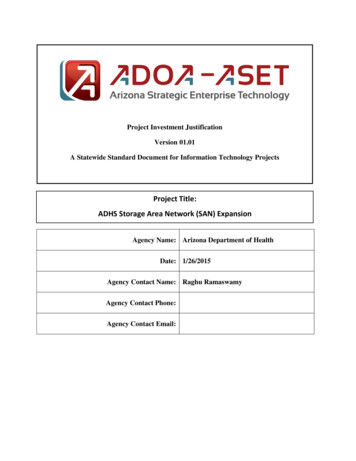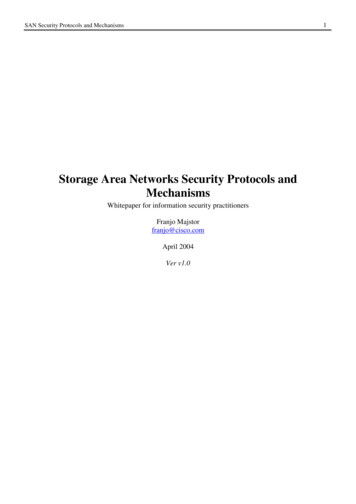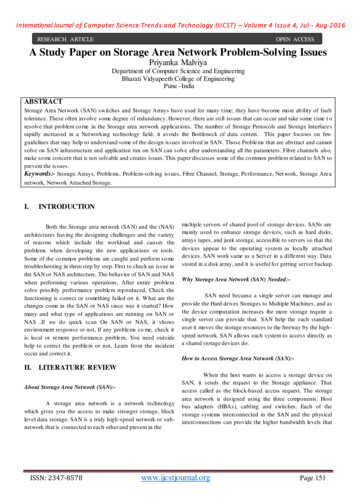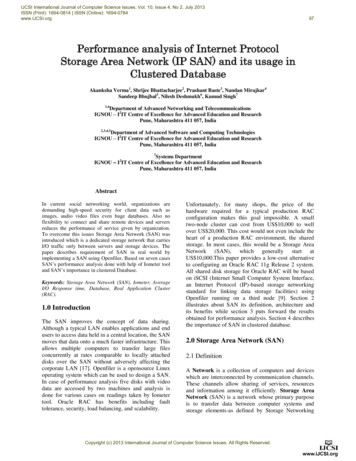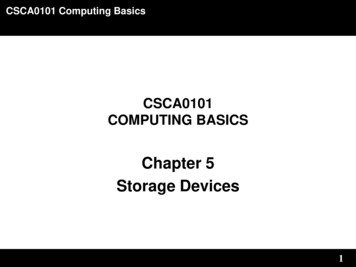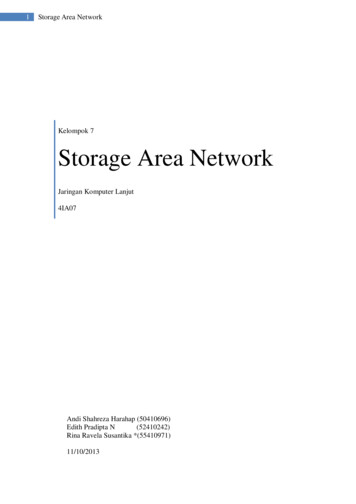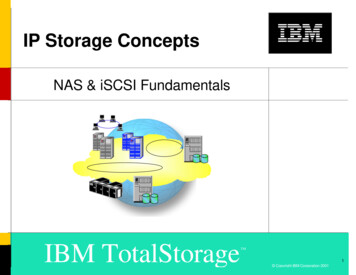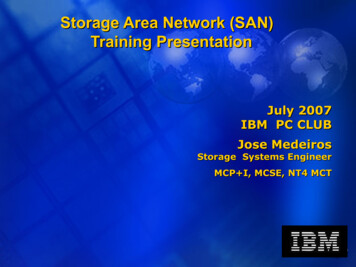
Transcription
Storage Area Network (SAN)Training PresentationJuly 2007IBM PC CLUBJose MedeirosStorage Systems EngineerMCP I, MCSE, NT4 MCT
Agenda Training ObjectivesBasic SAN information – TerminologySAN Infrastructure OverviewLive Demo of SANIntel Confidential2
Training Objectives Why do we need a SAN?Clear understanding of the basics of SANdesignBasic understanding of a SANinfrastructure and designLive DemonstrationIntel Confidential3
Basic SAN TerminologyObjective:Each of you will be familiar with thebuilding blocks of Fiber Based SAN.Intel Confidential4
Why do I need a SAN? What is Clustering?Intel Confidential5
Basic SAN Terminology How does a Cluster attach to a SAN?DAS SCSI, Fiber SAN, ISCSI SANFiber Networks, FDDI 100MBFiber Connector Types GBIC 1GB, SFP 2GB&4GB LCFiber Channel Switch & Fiber Channel HBA( Host Bus Adapter)ISCSI can also be used. Recommend adedicated 1GB network switch with MSExchange or MS SQL and a ISCSI HBA on theTarget and ISCSI Initiator Client Node.Intel Confidential6
Basics of SANsIntel Confidential7
Server Components of a SANIntel Confidential8
Emulex LightPulse UtilityIntel Confidential9
SAN Switch componentsIntel Confidential10
SAN Switch Components (cont)Intel Confidential11
Switch GUI InterfaceIntel Confidential12
Physical Layout–––RackPair of HSV110 controllersDrive enclosurescontaining array ofphysical disk drives– Loop switchesLoop Switches– Enclosures connect to FCloop switches in switchedconfigurations (shown)Controller PairDriveEnclosuresIntel Confidential13
Overview of Enterprise Virtual ArrayConnectionsIntel Confidential14
rear connections of EVA Controller– Two 2Gb/s FC-Switch fabric host ports– Four 2Gb/s FC-AL device ports– 2Gb/s FC cache mirroring port (device ports asLink Status LEDLoop Pair 2 Loop Pair 2 Powerbackups)Loop 2BUARTMemory CardUnused)SwitchMirror PortHost Fabric 1 and 2Loop Pair 1 Loop Pair 1Loop 1ALoop 1BEnclosure Address BusIntel ConfidentialLoop 2A15PowerConnector
Traditional RAID vs VraidSCSIBus 1SCSIBus 2RAIDSCSIBus 3SCSIBus 4SCSIBus 5SCSIBus 6Tedious, manualvolume placementand managementRAID 5 volumeRAID 0 volumeLogicalVraidIntel ConfidentialRAID 1 volumeVraid 5Virtual diskVraid 0Virtual diskPhysical16Vraid 1Virtual disk
Traditional Storage Array1. Adding drives – next they must be grouped together in disk groups by RAID level2. Carving out disk groups based on RAID level3. Laying out data4. Leaving stranded capacity – RAID-5 disk groups can’t access unused capacity fromRAID-1 disk groupsIntel Confidential17
Enterprise Virtual Array1. Adding drives – next they must be grouped together in disk groups2. Carve out the disk group(s) - typically EVAs are configured with only one or twodisk groups3. Lay out the data – all RAID-5 and RAID-1 data are sprinkled across all the drivesin the group – EVA disks format on the fly.Intel Confidential18
Adding Disks to the Traditional ArrayR1SP1. Add drives2. Configure disk groups – format disks3. Lay out data – RAID-5 data in RAID-5 LUNs, etc.Intel Confidential19
Adding Disks to the EVA1. Add disks2. Enlarge disk group to include the extra disks3. LUNs are stretched across new disks – data is re-leveled across all disks.Intel Confidential20
EVA Virtual Disk MappingDisk 1Disk 2Disk 3Disk 4Disk 5Disk 6Disk 7Disk 8Allocated Space for Distributed SparingMirror4 Mirror4 Mirror5 Mirror5 Mirror6 Mirror6 Mirror7 Mirror7Stripe9 Strip10 Mirror1 Mirror1 Mirror2 Mirror2 Mirror3 Mirror3VDisk4Raid 1 0Stripe1 Stripe2 Stripe3 Stripe4 Stripe5 Stripe6 Stripe7 Stripe8Mirror5 Mirror5 Mirror6 Mirror6 Mirror7 Mirror7 Mirror8 Mirror8Mirror1 Mirror1 Mirror2 Mirror2 Mirror3 Mirror3 Mirror4 ta1Data1Parity1Data2Mirror1Data2Data2Intel Confidential21VDisk3Raid 0VDisk2Raid 1 0VDisk1Raid 5
EVA Virtual Disk LevelingDisk 1Disk 2Disk 3Disk 4Disk 5Disk 6Disk 7Disk 8Allocated Space for Distributed SparingMirror4 Mirror4 Mirror5 Mirror5 Mirror6 Mirror6 Mirror7 Mirror7Stripe9 Strip10 Mirror1 Mirror1 Mirror2 Mirror2 Mirror3 Mirror3Stripe1 Stripe2 Stripe3 Stripe4 Stripe5 Stripe6 Stripe7 Stripe8Mirror5 Mirror5 Mirror6 Mirror6 Mirror7 Mirror7 Mirror8 Mirror8Mirror1 Mirror1 Mirror2 Mirror2 Mirror3 Mirror3 Mirror4 ta1Data1Parity1Data2Mirror1Data2Data2Intel Confidential22Disk 9Disk 10
EVA Distributed SparingDisk 1Disk 2Disk 3Disk 4Disk 5Disk 6Disk 7Disk 8Disk 9Disk 10Allocated Space for Distributed SparingMirror3 Mirror3 Mirror4 Mirror4 Mirror5 Mirror5 Mirror6 Mirror6 Mirror7 Mirror7Stripe5 Stripe6 Stripe7 Stripe8 Stripe9 Strip10 Mirror1 Mirror1 Mirror2 Mirror2Mirror6 Mirror6 Mirror7 Mirror7 Mirror8 Mirror8 Stripe1 Stripe2 Stripe3 Stripe4Mirror1 Mirror1 Mirror2 Mirror2 Mirror3 Mirror3 Mirror4 Mirror4 Mirror5 ty1Data2Mirror1Data2Data2Parity2Data2Intel Confidential23
Command View EVA – SimpleManagementEnter the Name of theVirtual Disk.Select the appropriateDisk Group from thepull down list.TransactionLogSelect Virtual DiskRedundancy Level.Enter the size ofVirtual Disk in GB.20Select a Host fromthe pull down list.Select the Preferredcontroller from thepull down list.Intel Confidential24
Intel Confidential25
Disaster RecoverySingle Datacenter ArchitectureOracle or SQL Cluster(existing)Oracle or SQL Clusterhp proliant DL580g2U IDPrimary SAN(existing)hp proliant DL580g2UID123Int1Ext2IntE xt344IPS A N S w itc h 2 /1 61 0 1 0 1011 0 1 0 101234567891 01 11 21 334567891 01 11 21 31 41 51 41 5IPS A N S w itc h 2 /1 62hp proliant DL580g2U IDIntE xthp proliant DL580g2UIDIntExt11Intel Confidential23426234Replication SAN for CA(new)
Cross Building ArchitectureHardware ReplicationBuilding 1Existing HP SAN HardwareOracle or SQL Database9 MicronFiber laiddownbetweenbuildingsBuilding 2HP Failover Hardware, andData Guard Oracle or SQLDatabase Replicationhp proliant DL580g2UIDIntExthp proliant DL580g2UID123IP11 0 1 0 1012S A N S w itc h 2 /1 634567891 01 11 21 334567891 01 11 21 31 41 51 0 1 0 1011 41 51 0 1 0 101234567891 01 11 21 334567891 01 11 21 3IP1 51 41 5S A N S w itc h 2 /1 6hp proliant DL580g22hp proliant DL580g2UID1Intel Confidential1 4IPS A N S w itc h 2 /1 622IPS A N S w itc h 2 /1 6023Ext411 0 1 0 1IntIntExtUID412723IntExt434
FREE SAN WEB BASED TRAINING HP Educationhttp://www.hp.com/educationBrocade xhttp://www.emulex.comIntel Confidential28
Thank you for your Time! Dilbert ( The Contractor )Intel Confidential29
Traditional Storage Array 1. Adding drives - next they must be grouped together in disk groups by RAID level 2. Carving out disk groups based on RAID level 3. Laying out data 4. Leaving stranded capacity - RAID-5 disk groups can't access unused capacity from RAID-1 disk groups

